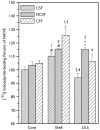Repeated sucrose access influences dopamine D2 receptor density in the striatum
- PMID: 12218708
- PMCID: PMC1945096
- DOI: 10.1097/00001756-200208270-00017
Repeated sucrose access influences dopamine D2 receptor density in the striatum
Abstract
A decrease in D2 dopamine receptor subtype (D2R) binding in the striatum has been reported in obese individuals and drug addicts. We examined D2R density in the striatum of food-restricted rats that had contingent access to food with different incentive values. Results showed that animals receiving limited access to 0.3 M sucrose paired 2 h with a chow meal for 7 days had a significantly lower D2R binding in nucleus accumbens shell and dorsolateral striatum compared with animals that had limited access to chow. There was no differential binding, however, in the accumbens core in any of the groups. These findings indicate that feeding conditions and sucrose intake influence D2R density specifically in subregions of the striatum.
Copyright 2002 Lippincott Williams & Wilkins.
Figures

References
-
- Leibowitz SF, Hoebel B. Behavioral neuroscience and obesity. In: Bray GA, Bouchard C, James PT, editors. The Handbook of Obesity. New York: Marcel Dekker; 1998. pp. 313–359.
-
- Wang GJ, Volkow ND, Logan J, et al. Lancet. 2001;357:354–357. - PubMed
-
- Cincotta AH, Tozzo E, Scislowski PW. Life Sci. 1997;61:951–956. - PubMed
-
- Ikemoto S, Panksepp J. Brain Res Brain Res Rev. 1999;31:6–41. - PubMed
-
- Hajnal A, Norgren R. Brain Res. 2001;904:76–84. - PubMed
Publication types
MeSH terms
Substances
Grants and funding
LinkOut - more resources
Full Text Sources

